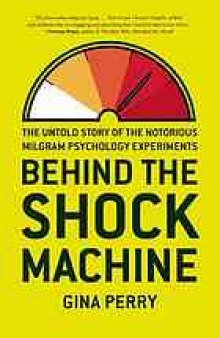 جزییات کتاب
جزییات کتاب
استنلی میلگرام یک روانشناس اجتماعی اهل ایالات متحده آمریکا بود. وی به خاطر آزمایش میلگرام مشهور است.
آزمایش میلگرم آزمایشی برای سنجش میزان اطاعت اشخاص از اقتدار یا اتوریته Authority یا آزمایش فرمانبرداری Obedience Experiment
در انجام کارهایی مغایر با وجدان شخصی افراد بود که به ابتکار روانشناس، استنلی میلگرام صورت گرفت.
نتایج این آزمایش برای اولین بار در سال ۱۹۶۳ در یک مجله روانشناسی چاپ شد.
In the summer of 1961, a group of men and women at Yale volunteered for a memory experiment to be conducted by the young, dynamic psychologist Stanley Milgram. The volunteers were placed in front of a shock machine and asked to administer a series of electric shocks to a man they'd just met. What they didn't know was that the man was an actor, the shocks were fake, and what was really being tested was just how far they would go. None of the participants could have foreseen the worldwide sensation the results would cause. Milgram reported that the volunteers had repeatedly shocked a man they believed to be in severe pain, possibly even dying, because an authority figure had told them to. He linked this behavior to atrocities perpetrated by ordinary people under the Nazi regime. In Behind the Shock Machine, psychologist and author Gina Perry unearths the full story of this controversial experiment and its startling repercussions. Interviewing the original participants and delving deep into the Yale archives and Milgram's unpublished files and notebooks, she pieces together a more complex picture of this flawed experiment: volunteers were not as obedient as later claimed; they were subjected to more intense and sustained pressure; some left unaware that the shocks had been faked; and, most significantly, many participants remain haunted by what they had done. Fleshed out with dramatic transcripts of the tests themselves, Perry puts a human face on the statistics and offers a gripping, unforgettable tale of one man's ambition and an experiment that defined a generation. Read more... Abstract: In the summer of 1961, a group of men and women at Yale volunteered for a memory experiment to be conducted by the young, dynamic psychologist Stanley Milgram. The volunteers were placed in front of a shock machine and asked to administer a series of electric shocks to a man they'd just met. What they didn't know was that the man was an actor, the shocks were fake, and what was really being tested was just how far they would go. None of the participants could have foreseen the worldwide sensation the results would cause. Milgram reported that the volunteers had repeatedly shocked a man they believed to be in severe pain, possibly even dying, because an authority figure had told them to. He linked this behavior to atrocities perpetrated by ordinary people under the Nazi regime. In Behind the Shock Machine, psychologist and author Gina Perry unearths the full story of this controversial experiment and its startling repercussions. Interviewing the original participants and delving deep into the Yale archives and Milgram's unpublished files and notebooks, she pieces together a more complex picture of this flawed experiment: volunteers were not as obedient as later claimed; they were subjected to more intense and sustained pressure; some left unaware that the shocks had been faked; and, most significantly, many participants remain haunted by what they had done. Fleshed out with dramatic transcripts of the tests themselves, Perry puts a human face on the statistics and offers a gripping, unforgettable tale of one man's ambition and an experiment that defined a generation
 درباره نویسنده
درباره نویسنده

گرم یکایی برای اندازهگیری جرم در دستگاه متریک است و نماد گرم در دستگاه بینالمللی یکاها g مخفف واژهٔ لاتین gramme است.
 دانلود کتاب
دانلود کتاب
 جزییات کتاب
جزییات کتاب
 درباره نویسنده
درباره نویسنده
 گرم یکایی برای اندازهگیری جرم در دستگاه متریک است و نماد گرم در دستگاه بینالمللی یکاها g مخفف واژهٔ لاتین gramme است.
گرم یکایی برای اندازهگیری جرم در دستگاه متریک است و نماد گرم در دستگاه بینالمللی یکاها g مخفف واژهٔ لاتین gramme است. 








 این کتاب رو مطالعه کردید؟ نظر شما چیست؟
این کتاب رو مطالعه کردید؟ نظر شما چیست؟
